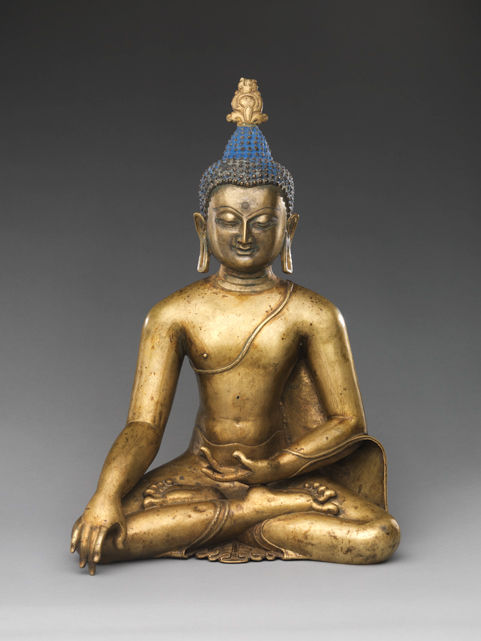
Buddha Sakyamuni, 12th–13th century. Central Tibet. Brass with color pigments. The Metropolitan Museum of Art, New York, Purchase, Lila Acheson Wallace, Oscar L. Tang, Anthony W. and Lulu C. Wang and Annette de la Renta Gifts, 2012 (2012.458)

Buddha Sakyamuni, 12th–13th century. Central Tibet. Brass with color pigments. The Metropolitan Museum of Art, New York, Purchase, Lila Acheson Wallace, Oscar L. Tang, Anthony W. and Lulu C. Wang and Annette de la Renta Gifts, 2012 (2012.458)
Masterpieces of Tibetan and
Nepalese Art
Recent Acquisitions
September 17, 2013–February 2, 2014 Gallery 251
The aesthetic achievements and sense of beauty of Tibetan and Nepalese art rest on complex cultural and religious foundations. Almost all the deities depicted originated in India, from where they were adapted and integrated into their respective cultural environments. While Buddhism predominated in Tibet, Hinduism and Buddhism evolved in parallel and have both been practiced in Nepal for many centuries, with profound theological and visual overlap. In this sense, it is in Nepal where the crosscurrents of Indo-Tibetan culture are perhaps most evident in its art.
In both cultural traditions, artist and patron accumulated merit for their respective roles in a work's creation, which was understood as an act of piety. As such, works of art were unsigned and their creators largely unknown, with a few notable exceptions, as seen in two rare examples in this exhibition. Significantly, itinerant Nepali artists were active in Tibet over many centuries, often leading to confusion as to the precise stylistic sources of Tibetan devotional objects. Nepali artists were renowned across the Himalayan region for their exceptional artistry. The strongest expression of Newar culture is concentrated in the Kathmandu Valley.
As religious images were created and consecrated for a precise purpose—to facilitate the visualization of a deity during worship—both Hindu and Buddhist traditions dictated that the iconographies of devotional objects conform to both the detailed descriptions of the gods prescribed in the sastras, technical treatises, and the tantras, a vast corpus of ritualistic texts. The unsurpassed physicality and spiritual grace of the works in this exhibition exemplify these two closely intertwined systems of presenting the Buddhist and Brahmanical deities in material form. As such, they reference the cultural, religious, and visual sensibilities of early India.
All the works presented here were once part of the Zimmerman Family Collection. Jack and Muriel Zimmerman began acquiring Tibetan and Nepalese art in 1964 and became among the foremost collectors of their generation in this field. During the formative period of Himalayan art appreciation, they assembled a group of works of unrivaled depth and quality. Fourteen of these masterpieces are presented here.
Head of Bhairava, the Wrathful Form of Shiva
- Date:
- 16th century
- Culture:
- Nepal
- Medium:
- Gilt copper with rock crystal and paint
- Dimensions:
- H. 32 in. (81.3 cm); W. 36 in. (91.4 cm); D. 14 in. (35.6 cm)
- Classification:
- Sculpture
- Credit Line:
- Gift of Zimmerman Family Collection, 2012
- Accession Number:
- 2012.444.2
This artwork is part of Masterpieces of Tibetan and Nepalese Art: Recent Acquisitions
This artwork is currently on display in Gallery 251


No comments:
Post a Comment